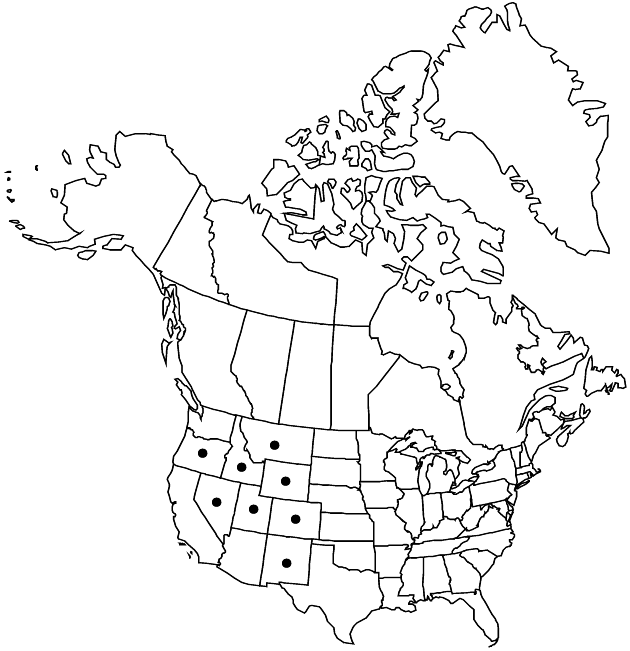Cirsium eatonii
Rhodora 13: 240. 1911.
Perennials, 10–150 cm; taprooted caudices. Stems 1–several, (fleshy), erect or ascending, simple to sparingly branched in distal 1/2, sometimes openly branched, glabrous to villous or tomentose with septate trichomes, sometimes ± glabrate; branches on distal stems 0–many, ascending. Leaves: blades oblong, 10–30 × 1–5 cm, margins usually strongly undulate, unlobed and spiny-dentate or shallowly to deeply pinnatifid with 10–20 pairs of lobes, teeth or lobes closely spaced, often overlapping, lance-oblong to broadly triangular, deeply 3-lobed, ± spiny-dentate, main spines 2–12 mm, abaxial faces glabrous or villous with septate trichomes along midveins to densely arachnoid-tomentose, adaxial glabrous or villous with septate trichomes along midveins; basal often present at flowering, spiny winged-petiolate or sessile; principal cauline many, well distributed, proximally ± winged-petiolate, distally sessile, gradually reduced; distal not much reduced, often closely subtending heads. Heads 1–many, erect or nodding, closely subtended by spiny-fringed bracts, usually sessile or short-pedunculate and crowded in subcapitate, spiciform, or racemiform (less commonly in openly branched) arrays. Peduncles 0–14+ cm. Involucres green or suffused with dark purple, broadly ovoid to campanulate, 2–5 × 1.5–5 cm (appearing wider when pressed), loosely to densely villous or tomentose with septate trichomes and/or arachnoid-tomentose with finer, non-septate trichomes. Phyllaries in 4–5 series, subequal, bases short-appressed, abaxial faces without or with very narrow glutinous ridge, apices usually stiffly ascending to spreading, linear-acicular, tapering to spines 7–35 mm; outer usually pinnately spiny, sometimes entire; apices of inner straight, plane or spine-tipped. Corollas ochroleucous or yellow to lavender, pink, or purple, 15–35 mm, tubes 3.5–10 mm, throats 5–14 mm, lobes (linear), 4–12.5 mm; style tips 3–6 mm, conspicuously exserted beyond corolla lobes. Cypselae dark brown, 5.5–7 mm, apical collars stramineous or not differentiated; pappi 12–25 mm.
Distribution

Colo., Idaho, Mont., N.Mex., Nev., Oreg., Utah, Wyo., Rocky Mountains and high peaks of Great Basin desert region.
Discussion
Varieties 7 (7 in the flora).
Cirsium eatonii is a polymorphic species widely distributed in a high elevation archipelago across the central Rocky Mountains and the Intermountain Region. During Pleistocene glacial episodes, the progenitors of this species complex undoubtedly occupied lower elevation sites and likely had more contiguous populations. Post-glacial isolation of these populations in allopatric high elevation sites has allowed them to differentiate to a greater or lesser extent. Prehistoric or recent introgressive hybridization with other thistle species probably has contributed to the diversification of the complex (R. J. Moore and C. Frankton 1965). Several of the races recognized here as varieties have been treated in the past as species (e.g., C. clokeyi, C. peckii). Their current geographic isolation and more or less distinctive features might support such recognition, but application of this approach across the complex would result in a proliferation of microspecies.
Selected References
None.
Lower Taxa
Key
| 1 | Involucres densely tomentose, individual phyllaries ± obscured by pubescence | > 2 |
| 1 | Involucres glabrous or thinly tomentose, individual phyllaries evident | > 5 |
| 2 | Arrays nodding; corollas yellow or pink to pale purple | Cirsium eatonii var. eriocephalum |
| 2 | Arrays erect; corollas white or pink to deep purple | > 3 |
| 3 | Corolla throats 8–11.5 mm; se Oregon, nw Nevada | Cirsium eatonii var. peckii |
| 3 | Corolla throats 3.5–8 mm | > 4 |
| 4 | Plants 50–150 cm, strictly erect; corollas pink or pale to deep purple; s Colorado | Cirsium eatonii var. hesperium |
| 4 | Plants 10–65 cm, ascending to erect; corollas white to pink or lavender; Idaho and Montana to Utah and n Colorado | Cirsium eatonii var. murdockii |
| 5 | Corollas usually 25–35 mm | > 6 |
| 5 | Corollas usually 17–25 mm | > 7 |
| 6 | Longest pappus bristles 16–18 mm | Cirsium eatonii var. clokeyi |
| 6 | Longest pappus bristles 20–25 mm | Cirsium eatonii var. viperinum |
| 7 | Most outer phyllaries with lateral spines; Nevada and Utah | Cirsium eatonii var. eatonii |
| 7 | Most outer phyllaries without lateral spines; nw Nevada and se Oregon | Cirsium eatonii var. peckii |